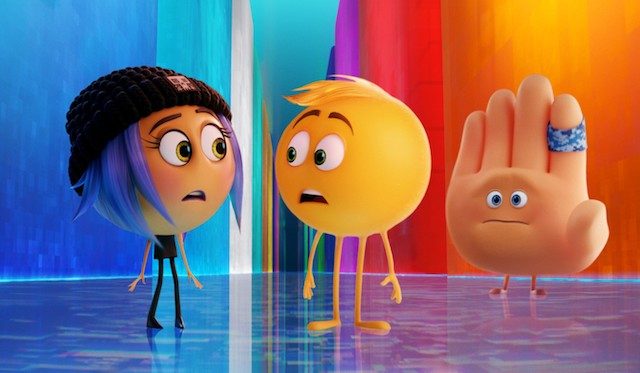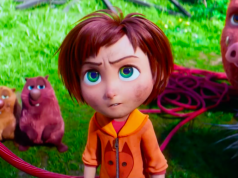
Hating “The Emoji Movie” is easy, not to mention fun, necessary, and appropriate. It’s like Trump. Though it represents humanity’s worst tendencies (laziness, vulgarity, cynicism) and we groan under the indignities suffered at its cartoonish hands, there’s comfort in having an enemy who’s entirely despicable. You can blast away all day long and never feel like you’ve gone too far.
Borrowing from “Toy Story,” “Wreck-It Ralph,” and the fever dreams of a syphilitic vaudevillian, “The Emoji Movie” is set in the digital city of Textopolis inside the text app of a smartphone belonging to a high school freshman named Alex (voice of Jake T. Austin). Our hero and narrator is Gene (T.J. Miller), the “meh” emoji, who’s about to have his first day on the job as one of the emojis Alex can use. The face emojis in Textopolis all have their designated expressions 24/7, even when they are feeling other emotions, but Gene has a problem: his face keeps registering how he feels! It’s hard to stay “meh” in such a wonderful, fascinating world!
And what is Textopolis like? It’s a teeming city full of mobile, sentient icons, pictures, and faces, who presumably spend their days just … being. Like the one that’s a Christmas tree? It just hops around saying “Merry Christmas” all the time. The poop emoji (Patrick Stewart) has exchanges with other emoji that go like this:
OTHER EMOJI: (referencing his leniency) You’re so soft, Poop!
POOP EMOJI: Not too soft, I hope!
What a life!
When Alex picks up his phone, all the emojis scramble to their individual cubes to await selection. When Alex chooses one, that emoji stands still and lets himself or herself be scanned; the scanned image is what’s sent to Alex’s screen. (The actual emojis themselves do not go anywhere. That would be ridiculous.)
Well, during Gene’s first outing (did Alex not have a “meh” emoji before today?), he panics and makes a bunch of faces while being scanned, resulting in a hideous image that only confuses the girl Alex sends it to. This causes Alex to believe his phone is buggy and should be erased and reformatted. Smiler (Maya Rudolph), the ever-grinning but ruthless leader of Textopolis (she was the first emoji, after all), declares that malfunctioning Gene must be deleted to save them all.
Pursued by virus-killing bots, Gene and his friend the High Five (James Corden) go on the run, leaving Textopolis and venturing into other apps on Alex’s phone. In the “piracy app” (the film avoids naming a specific one), they find a hacker named Jailbreak (Anna Faris) and persuade her to help them get off the phone and into the Cloud, where it’s safe. Jailbreak turns out to be a fellow emoji who left Textopolis (that’s a spoiler), but what about the other entities in the piracy app? There are “Internet trolls,” “spam,” a “Trojan horse” virus, and more — but unlike emojis, they don’t represent actual visible things. They’re concepts given arbitrary physical forms, and it DOESN’T MAKE ANY SENSE, GOOD DAY.
Anyway, thus begins the adventure, hopping around from app to app (Candy Crush, Spotify, YouTube, etc.), making countless easy references (not quite “jokes”) along the way, the bots on their tail, Gene having an existential crisis over what his purpose in life is. When they get to the cloud, Jailbreak the expert hacker’s big plan for getting in turns out to be trying to guess Alex’s password. Gene, High Five, and Jailbreak all learn lessons about … friendship? I guess?
Conceptually, the whole thing is a train wreck, only without the pleasure of being on a train. The director, Tony Leondis (“Igor”), conceived it with co-writer Eric Siegel (a TV producer with a few random writing credits), but they didn’t conceive it enough, getting no further than “What if emojis were alive?” (OK, they got a little further: “What if we could get a studio to pay us for saying ‘What if emojis were alive?’?”) Gene’s ability to express a variety of emotions turns out to be a good thing, but only because the movie says it is; it doesn’t actually make sense within the slipshod universe created here. (Seems to me the utility of an emoji whose meaning is ever-changing and unpredictable would be pretty low.)
In terms of message, the soul-crushingly depressing theme of the movie is summed up in one line: “If we help Alex connect to [the girl he likes], maybe he won’t delete us!” The movie is populated by yapping, unfunny, single-minded creatures who will be killed if they don’t prove themselves useful. And to be useful, they have to convey one thought at all times (except Gene, who can do whatever he wants), and help a 14-year-old boy flirt with a girl. That is their raison d’etre. Imagine the despair, not just of having such a limited purpose but being conscious of it. The film doesn’t address it, but surely Textopolis has the highest suicide rate of all the apps (except maybe LiveJournal).
To summarize: it’s an unworkable premise that never should have been a movie, that nobody thought would actually become a movie, and that, having become one anyway, puts forth no effort to be a good one and is as bad as everyone thought it would be. We need to make movies great again.
(NOTE: I didn’t use any emojis in this review because I am an adult.)
F (1 hr., 26 min.; )





